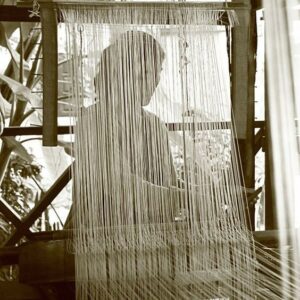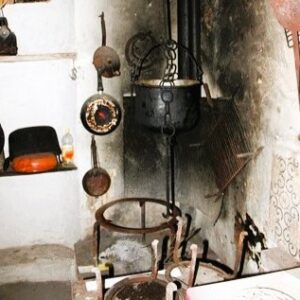Author: Vittoria Butera
The traditional attire worn by women varies in many details, basing of the area of origin. It also changes within the same village to accommodate shifting trends in production. Pictures from the late nineteenth century in Nocera show silk garments that lightened the elaborate costume.
Women’s silk costume. Nocera, late ‘800
When domestic silk production decreased and eventually disappeared, cotton from America was used due to its low prices. The end of silkworm breeding also changed the landscape as the large mulberry tree plantations, which were previously used to feed the worms, disappeared.
“A pacchiana” refers to both the regional clothing style and the women who wore it. The costume included common garments, lace, embroidery, and different local symbolic elements in its design.

Please remember the following description of traditional clothing:
‘U Mannile’: A headgear worn by women to cover their hair, typically in the form of a large handkerchief called maccatùru or tovagliòla. If it did not signify the marital status of the woman, it was dark in color. In some cases, it was the target of attacks by suitors who would forcibly remove it from the woman’s head, potentially leading to marriage.
‘A Cammisa’: A white cotton petticoat that was wide and reached the heels.
‘A Cammigetta or spinsa’: A blouse that varied in style based on different cultural traditions, featuring simple designs or intricate embroidery, ribbons, and lace. If a daring suitor untied the sleeve of the blouse, it would compromise the woman’s reputation.
‘U pannu: A long cloth worn on the shirt, wrapped around the body from the bust down. In certain regions, the color of this garment indicated marital status; red for married women, brown or dark plum for single women, and black for widows. These regions are referred to as “Countries of the Red Cloth” due to the significance of this garment.
‘U cursè’: A corset with wooden slats used to support the breasts; also known as jippune or bustinu.
‘A fadiglia or gunneddra’: A wide pleated skirt of dark colors such as blue, brown, or green.
‘U fadale or mantisinu’: An apron, where the style could indicate marital status in some regions.
‘U sciallu or sciarpune‘: A shawl made of various fabrics, such as silk for formal occasions.
‘ I quazietti’: wool or cotton stockings, reaching above the knee.
‘E lastiche’: elastic laces with the function of suspenders; they remained in use until the spread of tights.
The pants with the split, càuzi ccu ra spaccanza. In the pre-industrial society, clothes had to wear out through use, so they were passed down from father to son and from older brother to younger brother. If the pants of the older brother were too big, they were provided with suspenders, and required complex operations to lower and pull them up. Until the age of six or seven, children wore shorts with a split between the legs, which made it easier to take care of their physiological needs.
Pants with the split. Nocera, first-half of the 19th century
Footwear. In order to reduce the wear and tear on shoes, a protective layer was added. The heel area was studded with notches or metal dyes. Nails were used to reinforce the heel, preventing it from wearing out easily. Additionally, the front of the soles was strengthened by attaching crescent-shaped pieces of iron known as ‘e menzelune. This was particularly important for boys’ shoes, as their energetic activities tended to “strudenu puru ‘u fierru”, meaning “to wear out even iron”.
Shepherds wore simple shoes called purcìne, which they made themselves using reinforced leather. These shoes wrapped around the foot and were fastened with long white laces tied around the ankles. In coastal regions, fishermen also used this type of footwear, made from the tough skin of the pigfish.
The cloak, ‘u mantu was a type of cloak worn by the people of Calabria until the early 1900s. The style and quality of the cloak varied depending on the wearer’s social class. The nobility wore cloaks made of fine fabric with velvet or fur finishes, while the common folk wore rustic cloth cloaks known as “of the brigand”.
In families with limited resources, the mantle served a dual purpose, functioning as both a covering during the day and as a blanket at night. This practical use also carries symbolic meaning, as the act of sleeping or lying under a black cloak in many stories represents isolation from the world and a journey through time and space to gain wisdom and knowledge, or to be reborn into a new life.
Emigrants returning from America brought back a version of the cloak called cottu, which became popular in Calabria. Vittorio Butera humorously recalls the character of Japicu, who, after returning from America, pretentiously adopts the slang of the emigrants and wears cottu.
The belt, ‘a currìja, was a leather belt worn by the old Calabrians. It was typically used to hold up trousers and could also serve as a form of defense or offense, always easily accessible. Besides being a piece of clothing, it provided security and protection to the wearer. Among Nordic populations, the belt held a magical significance, as evidenced by various myths and archaeological findings, such as the discovery of a Neolithic body in Denmark in 1950 wearing a belt around its waist.
In Calabria, the belt served both defensive and offensive purposes. The head of the Calabrian family, inherited from the ancestral paterfamilias of ancient Rome, had the authority to decide the fate of his wife, children, and slaves, reflecting the feudal practice of disciplining peasants with the belt, a tradition then adopted by the landowner (‘u patrùne). The word currìja has an etymology related to the Greek words kurièuo, meaning dominate, and kùrios, meaning master, suggesting the belt’s association with strength and power in the Mediterranean culture.
Beachwear, ‘A Cammisa d’i Vagni. Until the early 1900s, women used to wear a long, wide white shirt when bathing, which, when wet, would reveal the body’s contours. Sometimes, these shirts would tear, causing laughter and jokes among onlookers.
Lifeguard Style Costume: In the mid-20th century, young women started wearing lifeguard-style swimsuits made of wool or heavy cotton, often knitted at home. When these swimsuits got wet, the yarn would stretch, sometimes revealing more than intended. Mothers would then cover their daughters with a sheet.
Bathing Headphones. In the later part of the 1900s, as swimwear evolved into two pieces, many women used colorful rubbery bathing headphones to protect their hair. Some of these headphones featured elaborate designs resembling flowers or marine elements. However, as the pleasure of bathing and showing off hairstyles prevailed, the use of these exhibitionist headphones declined.
The popularity of sports, swimming, and the desire to be proficient in these activities led to a decline in the use of life jackets among bathers. Now, only young children are allowed to wear one or two armrests, which are removed as soon as they are comfortable swimming on their own.
The hats: A distinctive feature of noblewomen was the hat with a veil. This garment was worn only for church and peer-to-peer visits, and it was not subject to usury. As a result, the ladies of the villages inherited them from their ancestors and owned several. The shape of the hat was quite similar, with variations in the veils, some simple and some with reliefs. Most of the veils were black, while some were marron (brown), blue, or purple, veiling the woman’s face with a mysterious charm.
‘A cùoppula: was a particular beret with a visor, typical of farmers. Men of good society typically wore the classic hat, reserving the cùoppula for sportswear, such as hunting or in the countryside.
It was also called cuoppula, the baby bonnet. ‘U tutubiscu. This word, which originally referred to a hat for clerics in the local dialect, has taken on an ironic meaning, used to mock women who, according to popular opinion, wore the hat inappropriately due to not being born into the gentry class. A dispute over the term’s meaning arose between Guido Cimino and Vittorio Butera, which was settled with a sonnet: “Cchi malanova fo ru tutubiscu\ e cchine ‘a prima vota l’ha ‘mmintatu!”.
The handkerchief, ‘u maccatùru. From mecàzo or mecàomai, which in Greek means moaning, bleating, uttering groans, the name maccatùru calls an object that comes into contact with bodily emissions.
Made of humble or precious fabric, sewn in an essential way or enriched with lace and embroidery, divided into male and female, the handkerchiefs were part of the woman’s outfit. A handkerchief, on whose edges the woman embroidered a significant phrase with red thread, was the first token of love, given stealthily in the first unofficial approaches. The lover showed it in his jacket pocket and jealously guarded it. If the engagement was interrupted, the handkerchief, being a symbol of love, had to be returned. In a serenade song, an ex-lover, who had not been accepted by the girl’s family, complains in seeing in another’s hand the handkerchief that one day had been his.
After having collected tears of joy and sorrow, after having been the bearer of the first message of love in the local tradition, the tissue tissue goes into extinction, submerged by the consumerist production of paper tissues, available in every business, proposed by the peddlers, incellofanati, all equal, in their way really democrats not making class or sex distinction.
Supramaniche e manicotti (sleeves): Women were obligated to enter holy places completely covered, so in the summer, they would sew on sleeves, either long or three-quarters in length, to wear in church. More fashion-minded women had a pair of supramaniche , also known as menze maniche (half sleeves), made from the same fabric as their dress, while others always used the same pair. This practice became common in the early twentieth century when families began to move away from traditional clothing. The next generation of girls from other classes would then discard the old clothes.
Even in Calabria, among high society ladies, a fashionable accessory for winter was the sleeve, a type of fur bag open at the sides to put their hands. The saying: “S’è ffattu mìntere intra ‘u manicotto” expressed dissent against a man who allowed himself to be manipulated by his wife.
The new feminine look, which did not completely cover the body like the traditional one, revealing part of the legs and arms, caused a sensation among both men and women. Evidence of this can be found in the satirical poem “Eva” by Vittorio Butera, which reflects the imagined comments:
Eva, quannu campava,\Era ccussì ‘nnucente\
Chi ppe’ ru Paradisu caminava\Cummigliata ccu nnente.
‘Nu juornu, ‘nu sirpente\‘A fice ‘mmizziare.
Le disse: – ‘Un te vrigùogni ‘e caminare\Deccussì…. trasparente? –
Allura ‘a povarella,\ A mmenu chi ve dicu,\
Se cusìu, cumu potte, ‘na gunnella\ Ccu’ ppampine de ficu.
Doppu, pped’anni ed anni,\Cchiù scannalu ppe’ ‘un dare,\De lana o sita, tutti quanti i panni\Se fìcedi accullare. Mo, parca s’è stuffata\E gira all’usu anticu\ Ccu mmancu, cumu prima, appiccicata\‘Na pampina de ficu!
Vittorio Butera
Translation: “Eve, when she lived,/ she was so innocent/ that she walked across heaven / covered with nothing. / One day, a snake, / shoved her./ It said,/ Aren’t you ashamed to walk / so… transparent? / Then the poor thing, / in less than I tell you, / sewed, as she could, a skirt / with fig leaves. /After, for years and years,/ more scandal not to give,/ of wool and silk all the cloths he had been saddled./ Now, it seems she is annoyed, / and turns to the ancient use / with not even, as before,/ sticked a fig leaf!”.



